
Gebroke Land: Armoede in die Afrikaanse gemeenskap sedert 1902
Check my rate
| Main centres: | 1-3 business days |
| Regional areas: | 3-4 business days |
| Remote areas: | 3-5 business days |

| Main centres: | 1-3 business days |
| Regional areas: | 3-4 business days |
| Remote areas: | 3-5 business days |
Published by Kraal Uiggewers in opdrag van Solidariteit Helpende Hand, 2009, 272 pages, illustrated, Afrikaans text, 25.2 cms x 33.3 cms, condition: new.
Seventeen scientists have written chapters for this collection which, as the title indicates, deals with poverty in the Afrikaans community since 1902. Although all Afrikaans speakers are considered by the editors to be part of the Afrikaans community, the book deals with the period before 1994 concerned, only about poverty among the white Afrikaners. The fact that the first Carnegie investigation, in the years 1929-1932, only focused on the so-called poor white question, must be seen within the context of that time.
The various themes and are of good scientific quality. After all, sometimes debatable statements are made. Here are some examples. On p. 96 it is stated that the influence of Abraham Kuyper's folk romantic thinking was mainly responsible for the fact that the NG Church of the thirties with its work of mercy first wanted to save the Afrikaner people from ruin and lost sight of the evangelical starting point. Strong nationalist feelings were present among the Afrikaners in these years, also among church leaders. The rise of African nationalism was caused by several factors; the influence of Kuyper's views played only a small role in this.
The book contains a number of photographs that were partly brought together and partly taken by the well-known photographer Paul Alberts. As Alberts himself explains, one sees poverty "on a person's body; (his) hands, eyes and the cracks in a face tell of hunger and hardship" (p. 11). Most of the photos are definitely striking. The impact would perhaps have been even greater if there had also been pictures of Afrikaans speakers leading a luxurious lifestyle to bring out the contrast between rich and poor. There are some photographs of whites in the early twentieth century performing manual labor in mines and on farms (especially pp. 37-39), a phenomenon that was common in European countries and also in America and Australia during those years and has not disappeared at all today either. Although this was probably not Alberts' intention, it may give the impression that white South Africans who perform manual labor are considered a sign of poverty. Especially residents of the above-mentioned countries who come across this book may possibly make such a conclusion.
So this work is not without flaws. Nevertheless, it is a valuable contribution to the literature on the issue of poverty among Afrikaans speakers. It does not contain much knowledge that cannot be found in other studies, but brings together information from a variety of sources and makes it accessible to the general reader.
Solidarity Helpende Hand probably mainly intended with this publication to make people more aware of the serious poverty issue that exists in the African community today. Helpende Hand itself has a long history of aid and is currently making, like the Helpmekaarbeweging, the Reddingsdaadbond and other bodies from earlier years, a very important contribution to alleviating poverty among, in particular, Afrikaans-speaking South Africans. In the last section, Langner, who is also executive director of Solidarity Helping Hand, states that poverty in the African community should be overcome as part of a larger South African solution and he indicates the organisation's course for the coming years on.